Nakajima Ki-43 Hayabusa
The Nakajima Ki-43 Hayabusa (隼, "Peregrine falcon"), formal Japanese designation Army Type 1 Fighter (一式戦闘機, Ichi-shiki sentōki) is a single-engine land-based tactical fighter used by the Imperial Japanese Army Air Service in World War II.
| Ki-43 "Hayabusa" | |
|---|---|
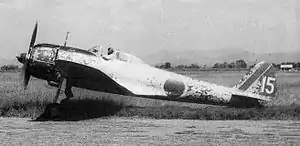 | |
| Role | Fighter aircraft |
| National origin | Japan |
| Manufacturer | Nakajima Aircraft Company |
| First flight | Early January 1939[1] |
| Introduction | October 1941[2] |
| Retired |
|
| Primary users | Imperial Japanese Army Air Service |
| Produced | 1939–1945 |
| Number built | 5,919 |
The Allied reporting name was "Oscar", but it was often called the "Army Zero" by American pilots because it bore a certain resemblance to the Mitsubishi A6M Zero,[3] the Imperial Japanese Navy's counterpart to the Ki-43. Both aircraft had generally similar layout and lines, and also used essentially the same Nakajima Sakae radial engine, with similar round cowlings and bubble-type canopies (the Oscar's being distinctly smaller and having much less framing than the A6M). While relatively easy for a trained eye to tell apart with the "finer" lines of the Ki-43's fuselage – especially towards the tail – and more tapered wing planform; in the heat of battle, given the brief glimpses and distraction of combat, Allied aviators frequently made mistakes in enemy aircraft identification in the heat of a dogfight, reportedly having fought "Zeros" in areas where there were no Navy fighters.
Like the Zero, the radial-engined Ki-43 was light and easy to fly and became legendary for its combat performance in East Asia in the early years of the war. It could outmaneuver any opponent, but did not initially have armor or self-sealing fuel tanks, and its armament was poor until its final version, which was produced as late as 1945.[4][5] Allied pilots often reported that the nimble Ki-43s were difficult targets but burned easily or broke apart with few hits.[6]
Total production amounted to 5,919 aircraft.[7] Many of these were used during the last months of the war for kamikaze missions against the American fleet.[6]
Design and development
The Ki-43 was designed by Hideo Itokawa, who would later become famous as a pioneer of Japanese rocketry. The Ki-43 prototype was produced in response to a December 1937 specification for a successor to the popular fixed-gear Nakajima Ki-27 Nate. The specification called for a top speed of 500 km/h (310 mph), a climb rate of 5,000 m (16,000 ft) in five minutes and a range of 800 km (500 mi). Maneuverability was to be at least as good as that of Ki-27.[8]
When first flown in early January 1939,[9] the Ki-43 prototype was a disappointment. Japanese test pilots complained that it was less maneuverable than the Ki-27 Nate and not much faster.[10] In order to solve these problems, Nakajima produced a series of progressively modified prototypes through 1939 and 1940. These changes involved a major weight saving program, a slimmer fuselage with the tail surfaces moved further aft and a new canopy. Crucially, the 11th prototype introduced the unique differential "butterfly" maneuvering Fowler flaps, which dramatically improved performance in tight turns. The 13th prototype combined all these changes, and tests of this aircraft resulted in an instruction for Nakajima to place the Ki-43 into production, the Ki-27 jigs being transferred to the Mansyu factory at Harbin in Japanese occupied Manchukuo.[11]
The Ki-43 (Oscar) was initially produced in November 1939, given the designation Ki-43-I. Deliveries from Nakajima's Ota factory commenced in February 1941. In addition to outstanding maneuverability, the Ki-43-I had an impressive rate of climb due to its light weight. Power was provided by the Nakajima Ha-25 engine turning a two-bladed, two-position variable-pitch metal propeller.[12] Top speed was 495 km/h (308 mph) at 4,000 m (13,000 ft)[13] The Ki-43 was equipped with two synchronized cowling machine guns in various configurations, with either two 7.7 mm (0.303 in) Type 89 machine guns, one 12.7 mm (0.50 in) Ho-103 machine gun and one 7.7 mm (0.303 in) gun, or two 12.7 mm (0.50 in) Ho-103 guns; the aircraft was given various sub-designations to reflect these differences. The configuration that appears to have been most prevalent at the outset of the war was the first configuration with two 7.7 mm (0.303 in) Type 89 machine guns, while as the war progressed the heavier combinations gained popularity and the version with the heaviest armament was sometimes given the designation Ki-43-Ic.[14] The Ho-103 was often loaded with explosive ammunition to increase target effect; its penetrative effect against later Allied aircraft armor appears to have been marginal.[14]
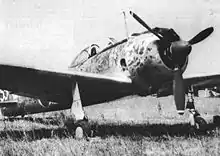
Prototypes for the Ki-43-II flew in February 1942. The Ha-25 engine was upgraded with the 2-stage supercharger, thus becoming the more powerful Nakajima Ha-115 engine, which was installed in a longer-chord cowling. The new engine turned a three-bladed propeller. The wing structure, which had suffered failures in the Ki-43-I, was strengthened and equipped with racks for drop tanks or bombs. The Ki-43-II was also fitted with a 13 mm (0.51 in) armor plate for the pilot's head and back, and the aircraft's fuel tanks were coated in rubber to form a crude self-sealing tank. This was later replaced by a 3-layer rubber bladder, 8mm core construction; with 2mm oil-proof lamination. The bladder proved to be highly resistant against 7.7 mm (0.303 in) bullets, but was not as effective against larger calibers.[15] The pilot also enjoyed a slightly taller canopy and a reflector gunsight in place of the earlier telescopic gunsight.[16] Nakajima commenced production of the Ki-43-II at its Ota factory in November 1942.[17] Production was also started at the Tachikawa Hikoki KK and the 1st Army Air Arsenal (Tachikawa Dai-Ichi Rikugun Kokusho), also at Tachikawa. Although Tachikawa Hikoki successfully managed to enter into large-scale production of the Ki-43, the 1st Army Air Arsenal was less successful – hampered by a shortage of skilled workers, it was ordered to stop production after 49 Ki-43s were built.[18] Nakajima eventually ceased production in mid-1944 in favor of the Ki-84 Hayate, but the Tachikawa Hikoki continued to produce the Ki-43.[19]
Tachikawa also produced the Ki-43-III, which utilized the more powerful Nakajima Army Type 1 Ha-115-II engine. Maximum speed increased to 576 km/h (358 mph).[19] Tachikawa produced 2124 Ki-43-II and -III aircraft between April 1944 and the end of the war.[20] Total production of all versions amounted to 5,919 aircraft.[13]
Operational history

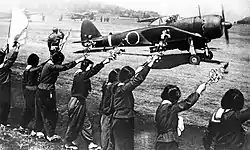
The Ki-43 was the most widely used Army fighter, and equipped 30 sentai FR (flight regiment) and 12 chutai IS (independent squadron). The first unit equipped with the Ki 43-I was the 59th FR at Hankow Airfield, during June–August 1941 and began operational sorties over Hengyang on 29 October 1941.[2][21] The second unit to re-equip with the new Aircraft was the 64th FR, from August to November 1941.[22]
The first version, Ki-43-I, entered service in 1941, the Ki-43-II in December 1942, the Ki-43-II-Kai in June 1943, and the Ki-43-IIIa in summer 1944. The aircraft fought in China, Burma, the Malay Peninsula, New Guinea, the Philippines, South Pacific islands and the Japanese home islands.[7]
Like the Zero, the Ki-43 initially enjoyed air superiority in the skies of Malaya, Netherlands East Indies, Burma and New Guinea. This was partly due to the better performance of the Oscar[23] and partly due to the relatively small numbers of combat-ready Allied fighters, mostly the Curtiss P-36 Hawk, Curtiss P-40, Brewster Buffalo, Hawker Hurricane and Curtiss-Wright CW-21 in Asia and the Pacific during the first months of the war. As the war progressed, however, the fighter suffered from the same weaknesses as the slower, fixed-gear Ki-27 "Nate" predecessor to the Oscar, and the more advanced naval A6M Zero; light armor and less-than-effective self-sealing fuel tanks, which caused high casualties in combat. Its armament of two machine guns also proved inadequate against the more heavily armored Allied aircraft. As newer Allied aircraft were introduced, such as the Republic P-47 Thunderbolt, Lockheed P-38 Lightning, North American P-51 Mustang, Vought F4U Corsair, Grumman F6F Hellcat, Yakovlev Yak-9, Yakovlev Yak-3U and late-model Supermarine Spitfire/Seafire, the Japanese were forced into a defensive war and most aircraft were flown by inexperienced pilots. However, even near the end, the Oscar's excellent maneuverability could still gain advantage over rash Allied pilots.
.jpg.webp)
From October to December 1944, 17 Ki-43s were shot down in air combat; their pilots claimed seven C-47s, five Consolidated B-24 Liberators, two Spitfires, two Bristol Beaufighters, two de Havilland Mosquitoes, two F4U Corsairs, two Boeing B-29 Superfortresses, one F6F Hellcat, one P-38, and one North American B-25 Mitchell.[24] Like most Japanese combat types, many Hayabusas were at the end expended in kamikaze strikes.
The Ki-43 also served in an air defense role over Formosa, Okinawa and the Japanese home islands. Some examples were supplied to the pro-Japanese regimes of Thailand, Manchukuo and Wang Jingwei Government as well. The Thai units sometimes fought against the USAAF in southern China.[25]
Hayabusas were well liked in the JAAF because of the pleasant flight characteristics and excellent maneuverability, and almost all JAAF fighter aces claimed victories with Hayabusa in some part of their career. At the end of the war, most Hayabusa units received Nakajima Ki-84 Hayate "Frank" and Kawasaki Ki-100 fighters, but some units flew the Hayabusa to the end of the war. The top-scoring Hayabusa pilot was Sergeant Satoshi Anabuki with 39 confirmed victories, almost all scored with the Ki-43.
After the war, some captured examples served in limited numbers in the French Air Force in Indochina against Viet Minh rebels.[26]
Ki-43s abandoned in the Netherlands East Indies were taken over by the newly declared Indonesian government and put into service during the fight against Dutch forces.
Variants
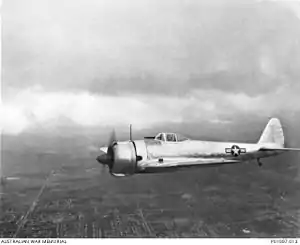
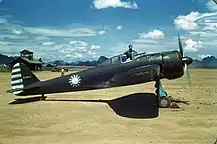
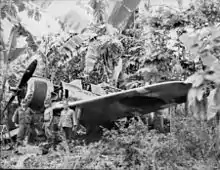
- Ki-43
- 13 Prototypes/pre-production aircraft.[27]
- Ki-43-I "Ko" (Mark 1a)
- Variant armed with 2 × 7.7 mm (0.303 in) Type 89 machine guns.[28][29]
- Ki-43-I "Otsu" (Mark 1b)
- Variant armed with one 12.7 mm (0.50 in) Ho-103 machine gun and 1 × 7.7 mm (0.303 in) Type 89.[30][29]
- Ki-43-I "Hei" (Mark 1c)
- Variant armed with 2 × 12.7 mm (0.50 in) Ho-103, plus ability to mount 2x30kg bombs under wings.[31] All earlier Ki-43-Ia "Ko" and Ki-43-Ib "Otsu" were gradually upgraded to this version as more Ho-103 became available.
- Ki-43-II
- 5 Prototypes, introduced the Ha-115 engine with two stage supercharger, shorter and stronger wings,[32] self-sealing fuel tanks, 13 mm (0.51 in) of pilot armor, reflector sight, three-bladed fixed pitch propeller, and an improved canopy.[31]
- Ki-43-II "Ko" (Mark 2a)
- First Ki-43-II production model. Improvements of the 5 prototypes added into the design. Ability to carry up to 500 kg (1,100 lb) of bombs.[33][31]
- Ki-43-II "Ko" upgraded
- Oil ring cooler changed to honeycomb type mounted under the nose. Improved landing light.[32]
- Ki-43-IIb "Otsu" (Mark 2b)
- Fuel cooling system added on some examples. Both exhaust pipes were angled backwards for slightly increased thrust. Universal drop tank racks mounted outboard of landing gear on later examples.[32] (earlier models sometimes had mounting points slightly inboard of the landing gear or on the centerline)
- Ki-43-II-KAI (Mark 2 improved)
- Later examples could carry bombs on the drop tank mountings.[32] This variant was tested with skis for operations from snow in Manchuria.[34] Fitted with ejector exhaust stacks[32] (adding approximately 30 hp) and additional 540-litre (140 US gal; 120 imp gal) fuel tank in fuselage.
- Ki-43-III
- Prototypes powered by Nakajima Ha-115-II engine of 920 kW (1,230 hp) Exhaust stack configuration slightly modified. Water-methanol injection added.[32]
- Ki-43-III "Ko" (Mark 3a)
- Only produced by Tachikawa plant.[35]
- Series production model, some fitted with skis for operations from snow.
- Ki-43-III "Otsu" (Mark 3b)
- Variant with the Mitsubishi Ha-112-II radial engine and armed with twin 20 mm (0.79 in) Ho-5 cannon. (Prototype – only 2 Built)[36]
- Ki-62 Project
- Advanced interceptor version of Nakajima Ki-43 with a more-powerful engine and armed with 30 mm (1.18 in) or 40 mm (1.57 in) cannons.
Production
| Year | |||||||||||||
|---|---|---|---|---|---|---|---|---|---|---|---|---|---|
| Jan. | Feb. | Mar. | Apr. | May | June | July | Aug. | Sept. | Oct. | Nov. | Dec. | Annual | |
| 1941 | 3 | 9 | 23 | 5 | 20 | 20 | 5 | 29 | 43 | 157 | |||
| 1942 | 40 | 26 | 47 | 61 | 51 | 57 | 61 | 37 | 56 | 55 | 46 | 79 | 616 |
| 1943 | 88 | 77 | 90 | 96 | 102 | 105 | 105 | 120 | 120 | 138 | 140 | 147 | 1,347 |
| 1944 | 179 | 181 | 167 | 140 | 155 | 125 | 84 | 28 | 11 | 1,070 | |||
| Total | 3,190 |
Not included:
- Ki-43-I's pre-production started with three prototypes completed in December 1938, as well as in February and March 1940. A further ten service trials aircraft were built from Nov. 1939 to Sept. 1940.[13]
- Ki-43-II's pre-production started with five prototypes completed during Feb. to May 1942. A further three service trials aircraft were built from June to Aug. 1942.[13]
- Ki-43-III's pre-production started with ten prototypes completed during May 1944 to August 1945.[13]
| Year | |||||||||||||
|---|---|---|---|---|---|---|---|---|---|---|---|---|---|
| Jan. | Feb. | Mar. | Apr. | May | June | July | Aug. | Sept. | Oct. | Nov. | Dec. | Annual | |
| 1943 | 5 | 7 | 10 | 15 | 20 | 30 | 45 | 67 | 199 | ||||
| 1944 | 10 | 115 | 100 | 140 | 125 | 147 | 148 | 157 | 210 | 75 | 275 | 180 | 1682 |
| 1945 | 105 | 90 | 155 | 70 | 120 | 93 | 80 | 35 | 748 | ||||
| Total | 2629 |
Not included:
- A further 49 Ki-43-II's were assembled from Oct. 1943 to Nov. 1944 at Tachikawa Dai-Ichi Rikugun Kokusho arsenal plant.[13]
| According to USSBS Report: 5,819 [37][38] | Figure includes: 5,819 Ki-43-I, Ki-43-II and Ki-43-IIIa builds |
| According to Francillon: 5,919 [13] | Figure includes: 729 Ki-43-I, 5,188 Ki-43-II and Ki-43-IIIa builds, 2 Ki-43-IIIb prototypes |
Operators
Wartime
- Royal Thai Air Force Operates 24 Ki-43 IIB aircraft.
Postwar
- Nationalist Chinese Air Force
- 6th Group
- Two squadrons operated captured aircraft.
- 6th Group
- Chinese Communist Air Force operated five aircraft captured from nationalists from 1946 until 1952.
- French Air Force Escadron de Chasse 1/7[39] operated captured aircraft in 1945–1946 Indo-China.[40]
- Indonesian Air Force repaired derelict aircraft to fight Dutch colonial rule. In 1947, the Ki-43 currently at the Museum Dirgantara Udara Yogyakarta near Adisucipto International Airport was to bomb Dutch strategic positions however mechanical problems grounded it.
- North Korean Air Force operated repaired derelict aircraft after the war.
Surviving aircraft
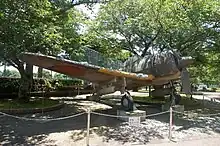
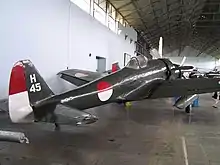
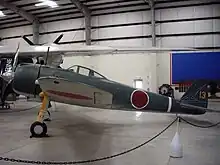
- 750 – Ki-43-I on display at Flying Heritage Collection in Everett, Washington.[41] Former ZK-OSC restored to flying condition by the Alpine Fighter Collection in the 1990s, not currently flying.[42]
- 5465 – Ki-43-II displayed unrestored at the Australian War Museum in Canberra, Australian Capital Territory.[43] The nose and tail are in the main museum building, while the wings and center section are in storage.[44]
- 6430 – Ki-43-IIb on display at the Pima Air & Space Museum in Tucson, Arizona.[45] This aircraft was previously on display at the EAA AirVenture Museum and the Museum of Flight and is on loan from the National Air and Space Museum.[46][47]
- Reproduction – Ki-43-IIIa on display at the Museum of Flight in Seattle, Washington. This aircraft contains parts from four different wrecks.[48] The restoration was begun by the Texas Airplane Factory and completed by GossHawk Unlimited.[49]
- Reproduction – Ki-43-IIIa at the Ericson Aircraft Collection in Madras, Oregon.[50] This aircraft was previously at the Tillamook Air Museum in Tillamook, Oregon.[51]
- Reproduction – Ki-43 originally under restoration/rebuild at Texas Airplane Factory, Meacham Field, Fort Worth, Texas from 4 wrecks.[52] Now located at GossHawk Unlimited in Casa Grande, Arizona.[53]
- Reproduction – Ki-43 originally under restoration/rebuild at Texas Airplane Factory, Meacham Field, Fort Worth, Texas.[52] Now located at GossHawk Unlimited in Casa Grande, Arizona.[53]
- Reproduction – Ki-43 on display outside Chiran Peace Museum for Kamikaze Pilots, Minamikyūshū, Kagoshima, Japan.[54][55]
- Unknown msn – Ki-43 awaiting restoration at The Fighter Collection in Duxford, United Kingdom. The aircraft is currently undergoing restoration by Nobuo Harada and will be placed on display at the Kawaguchiko Motor Museum when completed.[56]
- Unknown serial number – Ki-43 on display at Dirgantara Mandala Museum in Yogyakarta.[57]
- Unknown serial number – Ki-43 under restoration at the Kawaguchiko Motor Museum / Fighter Museum in Kawaguchiko, Yamanashi.[58][59][60]
Specifications (Ki-43-IIb)
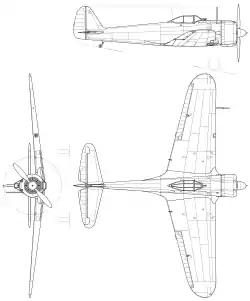
Data from Japanese Aircraft of the Pacific War[61]
General characteristics
- Crew: One
- Length: 8.92 m (29 ft 3 in)
- Wingspan: 10.84 m (35 ft 7 in)
- Height: 3.27 m (10 ft 9 in)
- Wing area: 21.4 m2 (230 sq ft)
- Airfoil: root: NN-12 mod. (18%); tip: NN-12 mod. (8%)[62]
- Empty weight: 1,910 kg (4,211 lb)
- Gross weight: 2,590 kg (5,710 lb)
- Max takeoff weight: 2,925 kg (6,449 lb)
- Powerplant: 1 × Nakajima Ha-115 14-cylinder air-cooled radial piston engine, 970 kW (1,300 hp) for take-off
- 890 kW (1,200 hp) at 3,000 m (9,800 ft)
- 820 kW (1,100 hp) at 6,200 m (20,300 ft)
- Propellers: 3-bladed metal constant-speed propeller
Performance
- Maximum speed: 530 km/h (330 mph, 290 kn) at 4,000 m (13,000 ft)
- Cruise speed: 440 km/h (270 mph, 240 kn)
- Range: 1,760 km (1,090 mi, 950 nmi)
- Ferry range: 3,200 km (2,000 mi, 1,700 nmi)
- Service ceiling: 11,200 m (36,700 ft)
- Time to altitude: 5,000 m (16,000 ft) in 5 minutes, 49 seconds
- Wing loading: 121 kg/m2 (25 lb/sq ft)
- Power/mass: 0.33 kW/kg (0.20 hp/lb)
Armament
- Guns:
- Ki-43-Ia: 2 × 7.7 mm (0.303 in) Type 89 machine guns
- Ki-43-Ib: 1 × 7.7 mm (0.303 in) Type 89 machine gun + 1x 12.7 mm (0.500 in) Ho-103
- Ki-43-Ic, IIa, IIb, II Kai and IIIa: 2 × 12.7 mm (0.500 in) Ho-103's in the forward fuselage with 270 rpg
- Ki-43-IIIb: 2 × 20 mm (0.787 in) Ho-5 cannon
- Bombs:
- Ki-43-I: 2 × 15 kg (33 lb) bombs
- Ki-43-II and III: 2 × 30 kg (66 lb) bombs or 2 × 250 kg (550 lb) bombs
- optional - 2 × 200 L (53 US gal; 44 imp gal) drop tanks (all versions)
See also
Related development
Aircraft of comparable role, configuration, and era
- Bloch MB.152
- Curtiss P-36 Hawk
- Curtiss-Wright CW-21
- Grumman F4F Wildcat
- IAR 80
- Macchi MC.200
- Mitsubishi A6M Zero
- Polikarpov I-180
- Reggiane Re.2000
- Supermarine Spitfire
- Vultee P-66 Vanguard
- Weiss Manfréd WM-23 Ezüst Nyíl
Related lists
References
Notes
- Francillon 1979, p. 207.
- Green, p. 74
- Stanaway 1999, p. 33
- Ethell 1995, pp. 98–99
- Green, pp. 77, 78
- Ethell 1995, p. 99
- Glancey 2006, p. 173
- Francillon 1979, p. 206.
- Francillon 1979, p. 166.
- Air International January 1980, p. 27
- Air International January 1980, pp. 27–28
- Air International January 1980, p. 28
- Francillon 1979, p. 214.
- Dunn, Richard L. "Nakajima Ki-43-I Armament: A Reassessment." warbirdforum.com. Retrieved: 18 October 2009.
- "Ki-43 "Hayabusa" by Thomas Bush".
- Air International January 1980, p. 44
- Francillon 1979, p. 210.
- Francillon 1979, p. 211.
- Francillon 1979, p. 214, Air International January 1980, p. 45
- Air International January 1980, p. 46
- Ikuhiko, Japanese Army Fighter Aces, 1931–45
- Izawa, 64th Flying Sentai, p.2
- Stanaway 1999, p. 9
- Ichimura 2009, p. 50
- j-aircraft.com/research "Royal Thai Air Force aircraft." j-aircraft.com. Retrieved: 18 October 2009.
- Dorr & Bishop 1996, p. 249
- Windrow & Francillon 1965, pp. 3–4
- Windrow & Francillon 1965, p. 4
- Bueschel 1995, p. 6
- Windrow & Francillon 1965, pp. 4–5
- Windrow & Francillon 1965, p. 5
- Nakajima ichishiki sentōki hayabusa. Tōkyō: Dai Nihon Kaiga. 2000. ISBN 4-499-22735-6. OCLC 166435828.
- Bueschel 1995, p. 10
- Windrow & Francillon 1965, p. 8
- Bueschel 1995, p. 11
- Windrow & Francillon 1965, p. 6
- USSBS, Appendix M., pp. 40–42
- USSBS, Appendix J., pp. 29–30
- March & Heathcott 1997, p. 75
- "French Counter-Insurgency Aircraft, 1946–1965." worldatwar.net. Retrieved: 18 October 2009.
- "NAKAJIMA KI-43 HAYABUSA (OSCAR)". Flying Heritage Collection. Friends of Flying Heritage. Archived from the original on 14 February 2016. Retrieved 7 February 2016.
- Taylan, Justin. "Ki-43-I Oscar Manufacture Number 750". Pacific Wrecks. Pacific Wrecks Incorporated. Retrieved 7 February 2016.
- "Nakajima Ki-43-II Hayabusa 'Oscar' : Imperial Japanese Army Air Force". Australian War Memorial. Retrieved 11 November 2018.
- Taylan, Justin. "Ki-43-II Oscar Manufacture Number 5465". Pacific Wrecks. Pacific Wrecks Incorporated. Retrieved 7 February 2016.
- "HAYABUSA (OSCAR)". Pima Air & Space Museum. Pimaair.org. Retrieved 7 February 2016.
- Pluth, Dave. "The Captured Oscars of Hollandia". j-aircraft.com. Retrieved 15 April 2015.
- "Nakajima Ki-43-IIb Hayabusa (Peregrine Falcon) OSCAR". Smithsonian National Air and Space Museum. National Air and Space Museum. Retrieved 7 February 2016.
- "Nakajima Ki-43-IIIa Hayabusa "Oscar" Reproduction". The Museum of Flight. The Museum of Flight. Retrieved 7 February 2016.
- "Nakajima Ki-43 II "Oscar"". GossHawk Unlimited. GossHawk Unlimited, Inc. Retrieved 25 February 2016.
- "Nakakima Ki-43 Oscar". Erickson Aircraft Collection. Erickson Aircraft Collection. Retrieved 7 February 2016.
- Taylan, Justin. "Ki-43-IIIa Oscar Manufacture Number 15344 (Replica)". Pacific Wrecks. Pacific Wrecks Incorporated. Retrieved 7 February 2016.
- Taylan, Justin. "Texas Airplane Factory". Pacific Wrecks. Pacific Wrecks Incorporated. Retrieved 7 February 2016.
- "Nakajima Ki-43 II "Oscar"". GossHawk Unlimited. GossHawk Unlimited, Inc. Retrieved 25 February 2016.
- kamikazeimages.net Retrieved 13 February 2018
- "Chiran Peace Museum for Kamikaze Pilots". Kamikaze Images. Retrieved 13 February 2018.
- News, Vintage Aviation (9 October 2013). "Nobuo Harada To Rebuild The Nakajima Ki-43 Hayabusa". Vintage Aviation News. Retrieved 19 August 2023.
{{cite web}}:|last=has generic name (help) - "H45 | Nakajima Ki-43-II Hayabusa | Indonesia - Air Force | Arjun Sarup". Retrieved 20 March 2020.
- Japanese collector restoring rare WWII plane October 8, 2013 Japan Times Retrieved 17 August 2016
- "Nobuo Harada To Rebuild The Nakajima Ki-43 Hayabusa". Warbirds News. Warbirds News. 9 October 2013. Retrieved 25 February 2016.
- Thompson, Paul J-HangarSpace – Aviation Museums Retrieved 8 September 2016
- Francillon 1979, pp. 213–214.
- Lednicer, David. "The Incomplete Guide to Airfoil Usage". m-selig.ae.illinois.edu. Retrieved 16 April 2019.
Bibliography
- Bueschel, Richard M. Nakajima Ki-43 Hayabusa I-III in Japanese Army Air Force RTAF-CAF-IPSF Service. Reading, Berkshire, UK: Osprey Publications, 1970. ISBN 0-85045-022-5.
- Bueschel, Richard M (1995). Nakajima Ki-43 Hayabusa I–III in Japanese Army Air Force ⋅ RTAF ⋅ CAF ⋅ IPSF Service. Atglen, Pennsylvania: Schiffer Books. ISBN 0-88740-804-4..
- Dorr, Robert F; Bishop, Chris (1996). Vietnam Air War Debrief. London: Aerospace. ISBN 1-874023-78-6.
- Ethell, Jeffrey. (1995). Aircraft of World War II. Glasgow: HarperCollins Publishers. ISBN 0-00-470849-0.
- Francillon, René J. (1979). Japanese Aircraft of the Pacific War (2nd ed.). London: Putnam & Company. ISBN 0-370-30251-6.
- Glancey, Jonathan (2006). Spitfire: The Illustrated Biography. London: Atlantic Books. ISBN 978-1-84354-528-6.
- Green, William. Warplanes of the Second World War, Volume Three: Fighters. London: Macdonald & Co. (Publishers), 1973 (seventh impression), First edition 1961. ISBN 0-356-01447-9.
- Green, William & Swanborough, Gordon (n.d.). "Pentagon Over the Islands: The Thirty-Year History of Indonesian Military Aviation". Air Enthusiast Quarterly (2): 154–162. ISSN 0143-5450.
- Green, William and Gordon Swanborough. WW2 Aircraft Fact Files, Japanese Army Fighters, part 2. London: Macdonald and Janes's, 1977. ISBN 0-354-01068-9.
- Huggins, Mark (May–June 1999). "Setting Sun: Japanese Air Defence of the Philippines 1944–1945". Air Enthusiast (81): 28–35. ISSN 0143-5450.
- Ichimura, Hiroshi. Ki-43 'Oscar' Aces of World War II. Oxford, UK: Osprey, 2009. ISBN 978-1-84603-408-4.
- March, Daniel J.; Heathcott, John, eds. (1997). The Aerospace Encyclopedia of Air Warfare Volume Two: 1945 to the Present. London: AIRtime Publishing. ISBN 1-874023-88-3.
- "Pacific Peregrine ... The Nakajima Ki.43 Hayabusa". Air International. Vol. 18, no. 1. Bromley, UK: Fine Scroll. January 1980. pp. 27–31, 44–46. ISBN 0-903234-41-6. ISSN 0306-5634.
- Pajdosz, Waldemar, Mark T. Wlodarczyk and Adam Jarski. Nakajima Ki 43 Hayabusa "Oscar" (in Polish), Monografie Lotnicze 48. Gdańsk: AJ-Press, 1998. ISBN 83-86208-97-X.
- Skulski, Przemysław. Nakajima Ki 43 Hayabusa "Oscar", seria Pod Lupa no.11 (Polish/English). Wrocław: Ace Publications, 1999. ISBN 83-86153-98-9.
- Soumille, Jean-Claude (September 1999). "Les avions japonais aux coleurs françaises" [Japanese Aircraft in French Colors]. Avions (in French) (78): 6–17. ISSN 1243-8650.
- Stanaway, John (1999). Nakajima Ki.43 "Hayabausa" : Allied code name 'Oscar'. Herbert Cance (1 ed.). Bennington, Vt.: Merriam Press. ISBN 1-57638-141-2. OCLC 44125994.
- United States Strategic Bombing Survey Aircraft Division. Nakajima Aircraft Company, Ltd. Corporation Report II, Washington, D.C. 1947.
- United States Strategic Bombing Survey Aircraft Division. Tachikawa Aircraft Company, Ltd. Corporation Report X, Washington, D.C. 1947.
- Windrow, Martin; Francillon, Rene J (1965). The Nakajime Ki-43 Hayabusa. Leatherhead, Surrey, UK: Profile Publications.</ref>
External links
- Nathan Sturman's Homepage
- Joe Baugher's Hayabusa files
- Nakajima Type 1 Model 1 Army Fighter (Ki 43-I) Armament – A Reassessment by Richard L. Dunn